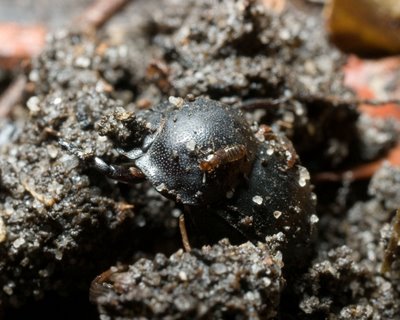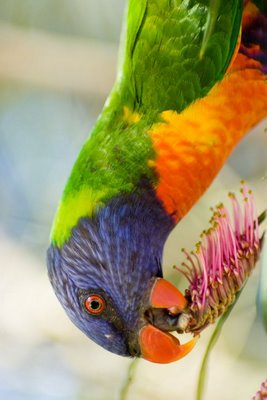 Was just about to go to bed when this cute image caught my eye. It's two different colourations of the red-backed toadlet Pseudophryne coriacea. Nice little frogs.
Was just about to go to bed when this cute image caught my eye. It's two different colourations of the red-backed toadlet Pseudophryne coriacea. Nice little frogs.
Wednesday, August 30, 2006
Rust and ash
 Was just about to go to bed when this cute image caught my eye. It's two different colourations of the red-backed toadlet Pseudophryne coriacea. Nice little frogs.
Was just about to go to bed when this cute image caught my eye. It's two different colourations of the red-backed toadlet Pseudophryne coriacea. Nice little frogs.
Tuesday, August 29, 2006
Wandering where to pupate?
 Snail over at A Snail's Eye View has written about Danaus plexippus, the Monarch or Wanderer butterfly here. What better opportunity to post a photo of the lovely larva! It's sitting on the seed pod of one of the species' host plants, Gomphocarpus, the swan plant, and appears to be in some sort of stand-off with a hemipteran of some description.
Snail over at A Snail's Eye View has written about Danaus plexippus, the Monarch or Wanderer butterfly here. What better opportunity to post a photo of the lovely larva! It's sitting on the seed pod of one of the species' host plants, Gomphocarpus, the swan plant, and appears to be in some sort of stand-off with a hemipteran of some description.It's not a species I'm overly familiar with and in fact I think this is one of the only times I've ever seen the caterpillar.
Teaser III
Teaser II
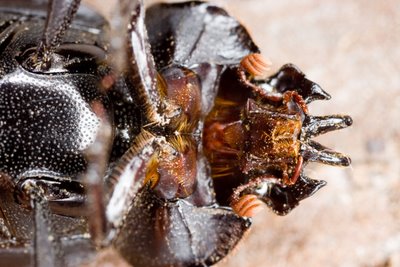 This image probably won't help anyone very much, but it's sort of inspired by darky's comments regarding the mouthparts of the beetle.
This image probably won't help anyone very much, but it's sort of inspired by darky's comments regarding the mouthparts of the beetle.That said, you could probably actually get down to species from this photo if you knew where to look.
Oh, and if anyone's interested, I've upgraded to blogger beta which turns out to be a mixed blessing. It appears to be no longer compatible with Picasa. And the new template tools looked promising but unfortunately were too rudimentary and inflexible for my needs.
Sunday, August 27, 2006
Teaser - Subterranean beast
 While on a walk at night recently I came upon a little beastie that happened to be active. It's a species that has a really interesting story to it, which I'll be spreading out over several posts. Or, at least, I'll show a few photos to get your interest up before revealing what it is. Unless someone guesses before that... Feel free to have a go.
While on a walk at night recently I came upon a little beastie that happened to be active. It's a species that has a really interesting story to it, which I'll be spreading out over several posts. Or, at least, I'll show a few photos to get your interest up before revealing what it is. Unless someone guesses before that... Feel free to have a go. 
Tuesday, August 22, 2006
Frog in the hole
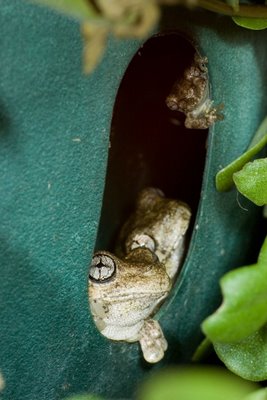 This is a photo that I always find rather cute. It shows three Peron's Treefrogs (Litoria peronii) peeking out of their daytime shelter prior to moving out and commencing the night's foraging.
This is a photo that I always find rather cute. It shows three Peron's Treefrogs (Litoria peronii) peeking out of their daytime shelter prior to moving out and commencing the night's foraging.I've always had this species in my garden though recently they seem to be having great success. The main 'source' population for the area has historically been a golf-course pond about a kilometre away, from which the frogs disperse into the suburbs (in some cases I've found tiny little frogs still with tail stubs appearing in my garden in late summer after making the mammoth journey).
The last two seasons, however, the frogs have bred in my garden, in bathtubs and other containers of water lying around. So there are more cute little baby frogs around than usual.
The shelter is a big hit with them; it's actually a hanging pot that has a separate reservoir on the bottom for holding water and keeping the soil moist. The frogs come and go through that little hole and spend their days nestled up in the crevice at the top.
Personally I find it pretty unlikely that all the frogs that found this spot did so independently (and in a count a couple of days ago there were something like four adults and three juveniles like the one at the top of the photo). So I'll be doing a bit of an investigation in my garden and elsewhere to try to determine whether these frogs are using some sort of scent-cue to locate shelters used by other frogs. I'm also interested in whether these frogs will choose to aggregate given the opportunity to spread themselves out in plenty of shelters.
So stay tuned, these frogs are going to become active in another couple of weeks and they're likely to do other interesting things like call, pair up and breed.

Saturday, August 19, 2006
Wednesday, August 16, 2006
Rain, spring and slugs
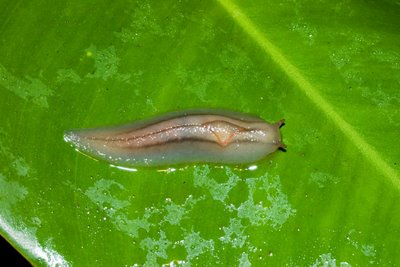 I'm not sure whether these slugs are active in winter, but last night I spotted this little blighter wandering across a wet leaf, and I'm going to take it as another 'sign of spring'. Yep, it's a Red-Triangle Slug (Triboniophorus graefei); I've shown some photos of the species in the past.
I'm not sure whether these slugs are active in winter, but last night I spotted this little blighter wandering across a wet leaf, and I'm going to take it as another 'sign of spring'. Yep, it's a Red-Triangle Slug (Triboniophorus graefei); I've shown some photos of the species in the past.The difference is that this one's a juvenile which is in the process of losing the three dark longitudinal lines (juvenile colouration) and gaining the red triangle that's seen in adults.
Oh, and another sign of warmer weather here tonight - the sound of a little microbat flying over.

Tuesday, August 15, 2006
Common as mud Eastern Froglet
 If you live in coastal south-eastern Australia, chances are you've encountered at least one frog species. And this is probably it. It's the Common Eastern Froglet, Crinia signifera. You've probably at least heard its call - vocalised even in the day, all year round. Curiously, individual or groups of males call in concert and out of phase with other individuals/groups. Hard to explain, but basically the classic 'call' that you hear of this frog is made up of at least two frogs at different pitches.
If you live in coastal south-eastern Australia, chances are you've encountered at least one frog species. And this is probably it. It's the Common Eastern Froglet, Crinia signifera. You've probably at least heard its call - vocalised even in the day, all year round. Curiously, individual or groups of males call in concert and out of phase with other individuals/groups. Hard to explain, but basically the classic 'call' that you hear of this frog is made up of at least two frogs at different pitches.I found the frog on the left (photographed semi-submerged in water) when out in the bush a couple of weeks ago - it appeared swimming around in a small pool in a stream. Despite my presence, it kept its vocal sac semi-inflated.

It reminded me of a C. signifera that I found a few years ago (pictured right). This frog stayed completely inflated despite being handled, prodded and photographed!

Sunday, August 13, 2006
Casting the net
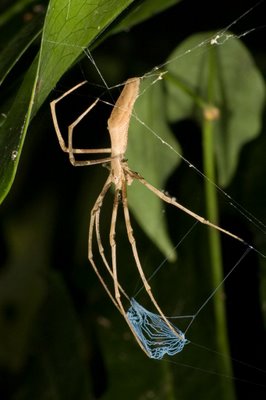 While I was out frogging a couple of weeks ago I was surprised to find a certain spider that I'm familiar with, Deinopis subrufa or the Net-Casting Spider. Surprised because it was the middle of Winter, when most honest invertebrates are dead, inactive or overwintering as eggs. So, an opportunity to show some photos and describe the species. Of course, a lot of you would have already learnt about this critter from Life in the Undergrowth (funnily enough it was actually I who suggested it for inclusion in the series to one of the BBC team's researchers).
While I was out frogging a couple of weeks ago I was surprised to find a certain spider that I'm familiar with, Deinopis subrufa or the Net-Casting Spider. Surprised because it was the middle of Winter, when most honest invertebrates are dead, inactive or overwintering as eggs. So, an opportunity to show some photos and describe the species. Of course, a lot of you would have already learnt about this critter from Life in the Undergrowth (funnily enough it was actually I who suggested it for inclusion in the series to one of the BBC team's researchers).As you can see, Deinopis doesn't build a web. Rather, it creates the small rectangular net out of a wooly bluish silk (below left), and holds the corners as it hangs from silken infrastructure at night. When an unsuspecting prey item trundles past below it, the spider stretches the net out and down over its victim. The spider relies heavily on its vision to spot its prey, and to do this has some spectacular eyes.
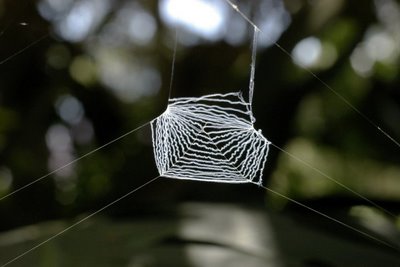
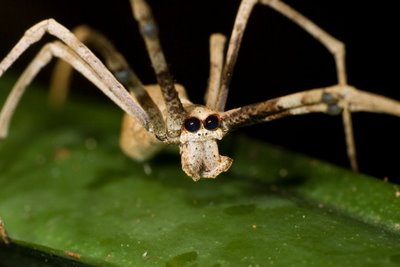
I found out something interesting about this animal's eyes recently. Photoreceptor cells have photopigments residing on their membranes, so a high surface area is required to pack in lots of pigment and absorb lots of light. This is achieved by having cilia or microvilli (rhabdomeres).
So you'd expect a creature like Deinopis to have receptors packed with rhabdomeres. However, if you were to grab a spider in the daytime and have a look at its photoreceptors, you'd find that its receptors had only about 15% of their space occupied by rhabdomeres - not too impressive. But during the daytime, the spider just rests and doesn't need to see very well; plus there's a lot more light available. In the night-time, when it's ready for ambush, if you looked at its receptors again, you'd find that a whopping 90% of each receptor's space is filled with rhabdomeres. That increase translates to a 74% photon catch at night-time compared with 6% in the day! About 2 hours after sunrise, the spider is actually destroying the (presumably costly) surplus membrane and then rebuilding it at dusk.
Oh - and another tidbit about the eyes of this animal: they're single-lensed, just like ours and unlike the compound eyes of insects. And for the photographers out there that drool over lenses that are f/1.2, consider the F-number of the eyes of this spider: f/0.58! Human eyes come in much more poorly at about f/2.1 in the dark and f/8.3 in bright light.
References:
Blest, A. D., 1978. The rapid synthesis and destruction of photoreceptor membrane by a dinopid spider: a daily cycle. Proceedings of the Royal Society of London Series B. 200:463-483.

Saturday, August 12, 2006
Clever frog puts eggs in multiple baskets
It's that time of the year where I'm about sick of the cold. It's depressing to look around and find so few invertebrates active. I start telling myself that it's just about spring-time already. Actually today was quite nice in Sydney, the sun shone and it was t-shirt weather for most of the day. Yesterday I saw a Spring Bee (Trichocolletes venustus) on the first Hardenbergia to flower. A couple of Perons Treefrogs have cackled preparatorily from their hideouts during the daytime. So spring is well and truly on the way, in my mind at least. A couple of weeks ago it was still pretty optimistic for me to be going frogging, but I had a bit of cabin fever and had an idea that the species I was after wouldn't disappoint.
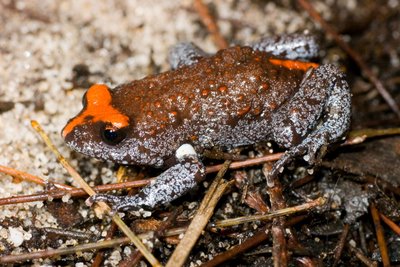 Most frogs breed in spring and summer, though in a country like Australia there's a fair bit of uncertainty about when the rain will fall, if at all, so a lot of frogs are pretty opportunistic. Some frogs will breed only in winter however, for example the Jervis Bay Treefrog (Litoria jervisiensis). This strategy always seems pretty crazy to me. Frogs don't regulate their body temperature physiologically, and it's surprising to me at least that winter-breeders manage to have enough energy to call at low temperatures. Then there's the investment that spawning takes! Winter is a time to save your resources, not chuck them in a pond! You rarely see most snakes and lizards in winter, but these frogs are at their most conspicuous at these times! Forgive my rant, it's just that these little squishy frogs are made of much sterner stuff than a lot of people would think. Oh, one last example. Another winter-breeding treefrog, Litoria littlejohnni (not named after our PM, BTW, but Murray Littlejohn), has been recorded down at Barren Grounds calling at just three degrees above zero!
Most frogs breed in spring and summer, though in a country like Australia there's a fair bit of uncertainty about when the rain will fall, if at all, so a lot of frogs are pretty opportunistic. Some frogs will breed only in winter however, for example the Jervis Bay Treefrog (Litoria jervisiensis). This strategy always seems pretty crazy to me. Frogs don't regulate their body temperature physiologically, and it's surprising to me at least that winter-breeders manage to have enough energy to call at low temperatures. Then there's the investment that spawning takes! Winter is a time to save your resources, not chuck them in a pond! You rarely see most snakes and lizards in winter, but these frogs are at their most conspicuous at these times! Forgive my rant, it's just that these little squishy frogs are made of much sterner stuff than a lot of people would think. Oh, one last example. Another winter-breeding treefrog, Litoria littlejohnni (not named after our PM, BTW, but Murray Littlejohn), has been recorded down at Barren Grounds calling at just three degrees above zero!
Time to cut to the chase, I think. The frog I was after two weeks ago isn't really a winter-breeding frog, but atypically, more of an all-year-round frog. It's the Red-Crowned Toadlet, Pseudophryne australis. This species is pretty special in many aspects. It's a very relevant frog to Sydneysiders as it is tightly linked to the Hawkesbury sandstone of the area and isn't found outside the greater Sydney Basin. It's a striking frog, like many Pseudophryne species (the genus includes the two species of stunning Corroborree frogs), and its colouration hints at its toxic nature. That red that looks so obvious doesn't actually make the frog that noticeable, however, as wet fallen Eucalyptus leaves that make up the leaf litter it inhabits often show a similar colour.
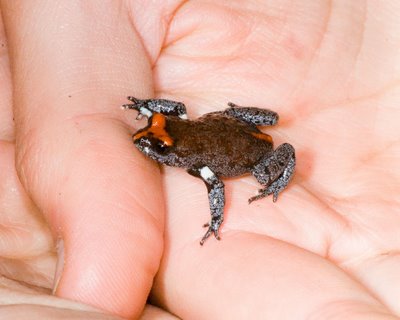 This little frog is believed to have declined quite considerably from the numbers it once existed in. A large part of the story of its decline is probably urbanisation. Building, clearing, pollution, bush-rock removal - the same tale of a lot of Sydney's declining wildlife. I quote Richard Wells (2002), a herper in Sydney, describing his experiences with this frog from 1965:
This little frog is believed to have declined quite considerably from the numbers it once existed in. A large part of the story of its decline is probably urbanisation. Building, clearing, pollution, bush-rock removal - the same tale of a lot of Sydney's declining wildlife. I quote Richard Wells (2002), a herper in Sydney, describing his experiences with this frog from 1965:
"They were just so common that I thought that everything about their life history would have been long ago recorded and usually I just about ignored them"
Jump forward to the present:
"...the little frog I found once so commonly 35 years ago is now thought by some to be at risk of extinction. If someone had told me that this could happen to that species back in 1965 I would have laughed in their face."
A sobering tale. This species really appears to live life on the edge, and in more ways than one. Some recent work by Karen Thumm for her PhD (supervised by Mike Mahony) had some interesting findings and implications for the natural history of the frog. Basically, after the frog oviposits (the clutch is laid on land in moist leaf-litter, then when the tadpoles hatch they develop further in small pools), the eggs within a single brood take a variable amount of time to hatch, and tadpoles hatch at various stages of development. Why? The hypothesis is that the frog is 'bet-hedging' in the face of Sydney's particularly unpredictable rainfall (Thumm & Mahony 2002).
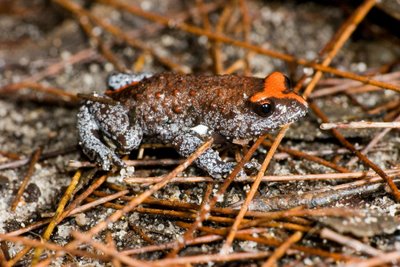 "Rain does not fall in a wet season or in any predictable pattern in the Sydney Basin. The advantage or disadvantage of delaying hatching depends on unpredictable future rain conditions.A strategy for optimal hatching times cannot evolve. If all embryos hatched at the same time, there would be a high chance of total reproductive failure. It appears that in the absence of a clear environmental signal, hatching is staggered in order to spread risk."
"Rain does not fall in a wet season or in any predictable pattern in the Sydney Basin. The advantage or disadvantage of delaying hatching depends on unpredictable future rain conditions.A strategy for optimal hatching times cannot evolve. If all embryos hatched at the same time, there would be a high chance of total reproductive failure. It appears that in the absence of a clear environmental signal, hatching is staggered in order to spread risk."
I've done a bit of a hopeless job of explaining very much about this frog, but this post is long enough already, so I recommend you read some of the below sources. Or I may blog about it again in the future.
References and further reading:
Thumm, K. & Mahony, M. (2002). Hatching dynamics and bet-hedging in a temperate frog, Pseudophryne australis (Anura: Myobatrachidae). Amphibia-Reptilia 23, 433-444.
Wells, R. (2002). Notes on the Red-crowned Toadlet Pseudophryne (Pseudophryne) australis (Gray, 1835) - an endangered frog from the Sydney Basin of New South Wales. Australian Biodiversity Record (4), 1-28. Link (well worth a read): http://forum.kingsnake.com/tax/messages/1027.html
Red-Crowned Toadlet Threatened Species information at National Parks: http://www.nationalparks.nsw.gov.au/PDFs/tsprofile_redcrowned_toadlet.pdf
 Most frogs breed in spring and summer, though in a country like Australia there's a fair bit of uncertainty about when the rain will fall, if at all, so a lot of frogs are pretty opportunistic. Some frogs will breed only in winter however, for example the Jervis Bay Treefrog (Litoria jervisiensis). This strategy always seems pretty crazy to me. Frogs don't regulate their body temperature physiologically, and it's surprising to me at least that winter-breeders manage to have enough energy to call at low temperatures. Then there's the investment that spawning takes! Winter is a time to save your resources, not chuck them in a pond! You rarely see most snakes and lizards in winter, but these frogs are at their most conspicuous at these times! Forgive my rant, it's just that these little squishy frogs are made of much sterner stuff than a lot of people would think. Oh, one last example. Another winter-breeding treefrog, Litoria littlejohnni (not named after our PM, BTW, but Murray Littlejohn), has been recorded down at Barren Grounds calling at just three degrees above zero!
Most frogs breed in spring and summer, though in a country like Australia there's a fair bit of uncertainty about when the rain will fall, if at all, so a lot of frogs are pretty opportunistic. Some frogs will breed only in winter however, for example the Jervis Bay Treefrog (Litoria jervisiensis). This strategy always seems pretty crazy to me. Frogs don't regulate their body temperature physiologically, and it's surprising to me at least that winter-breeders manage to have enough energy to call at low temperatures. Then there's the investment that spawning takes! Winter is a time to save your resources, not chuck them in a pond! You rarely see most snakes and lizards in winter, but these frogs are at their most conspicuous at these times! Forgive my rant, it's just that these little squishy frogs are made of much sterner stuff than a lot of people would think. Oh, one last example. Another winter-breeding treefrog, Litoria littlejohnni (not named after our PM, BTW, but Murray Littlejohn), has been recorded down at Barren Grounds calling at just three degrees above zero!Time to cut to the chase, I think. The frog I was after two weeks ago isn't really a winter-breeding frog, but atypically, more of an all-year-round frog. It's the Red-Crowned Toadlet, Pseudophryne australis. This species is pretty special in many aspects. It's a very relevant frog to Sydneysiders as it is tightly linked to the Hawkesbury sandstone of the area and isn't found outside the greater Sydney Basin. It's a striking frog, like many Pseudophryne species (the genus includes the two species of stunning Corroborree frogs), and its colouration hints at its toxic nature. That red that looks so obvious doesn't actually make the frog that noticeable, however, as wet fallen Eucalyptus leaves that make up the leaf litter it inhabits often show a similar colour.
 This little frog is believed to have declined quite considerably from the numbers it once existed in. A large part of the story of its decline is probably urbanisation. Building, clearing, pollution, bush-rock removal - the same tale of a lot of Sydney's declining wildlife. I quote Richard Wells (2002), a herper in Sydney, describing his experiences with this frog from 1965:
This little frog is believed to have declined quite considerably from the numbers it once existed in. A large part of the story of its decline is probably urbanisation. Building, clearing, pollution, bush-rock removal - the same tale of a lot of Sydney's declining wildlife. I quote Richard Wells (2002), a herper in Sydney, describing his experiences with this frog from 1965:"They were just so common that I thought that everything about their life history would have been long ago recorded and usually I just about ignored them"
Jump forward to the present:
"...the little frog I found once so commonly 35 years ago is now thought by some to be at risk of extinction. If someone had told me that this could happen to that species back in 1965 I would have laughed in their face."
A sobering tale. This species really appears to live life on the edge, and in more ways than one. Some recent work by Karen Thumm for her PhD (supervised by Mike Mahony) had some interesting findings and implications for the natural history of the frog. Basically, after the frog oviposits (the clutch is laid on land in moist leaf-litter, then when the tadpoles hatch they develop further in small pools), the eggs within a single brood take a variable amount of time to hatch, and tadpoles hatch at various stages of development. Why? The hypothesis is that the frog is 'bet-hedging' in the face of Sydney's particularly unpredictable rainfall (Thumm & Mahony 2002).
 "Rain does not fall in a wet season or in any predictable pattern in the Sydney Basin. The advantage or disadvantage of delaying hatching depends on unpredictable future rain conditions.A strategy for optimal hatching times cannot evolve. If all embryos hatched at the same time, there would be a high chance of total reproductive failure. It appears that in the absence of a clear environmental signal, hatching is staggered in order to spread risk."
"Rain does not fall in a wet season or in any predictable pattern in the Sydney Basin. The advantage or disadvantage of delaying hatching depends on unpredictable future rain conditions.A strategy for optimal hatching times cannot evolve. If all embryos hatched at the same time, there would be a high chance of total reproductive failure. It appears that in the absence of a clear environmental signal, hatching is staggered in order to spread risk."I've done a bit of a hopeless job of explaining very much about this frog, but this post is long enough already, so I recommend you read some of the below sources. Or I may blog about it again in the future.
References and further reading:
Thumm, K. & Mahony, M. (2002). Hatching dynamics and bet-hedging in a temperate frog, Pseudophryne australis (Anura: Myobatrachidae). Amphibia-Reptilia 23, 433-444.
Wells, R. (2002). Notes on the Red-crowned Toadlet Pseudophryne (Pseudophryne) australis (Gray, 1835) - an endangered frog from the Sydney Basin of New South Wales. Australian Biodiversity Record (4), 1-28. Link (well worth a read): http://forum.kingsnake.com/tax/messages/1027.html
Red-Crowned Toadlet Threatened Species information at National Parks: http://www.nationalparks.nsw.gov.au/PDFs/tsprofile_redcrowned_toadlet.pdf

Subscribe to:
Posts (Atom)
